This bend is similar to the Fisherman's Knot (below), except that it uses Adjustable Grip Hitches instead of Overhand Knots.
Using one end of rope, tie an Adjustable Grip Hitch around the other end of rope (pictures 1 and 2). Dress and set the knot, then flip the rope over and once again tie an Adjustable Grip Hitch around the other end of rope (which is partially displayed in picture 3). In picture 2, notice that the end of rope with a yellow square on it is pointing down and to the left, and when you flip the rope over (picture 3) then the end of rope with a yellow square is now pointing up and to the right. After you dress and set both knots, you can position them anywhere along the rope and they'll hold their position (picture 4).
 -1
-1
 -2
-2
 -3
-3
 -4
-4
According to Budworth, "This practical slide-and-grip knot can be grasped and shifted easily by hand in either direction but locks up firmly under load. After the load is removed, the knot may be slid along the rope again. The momentum of a fall will cause the knot to slide and so absorb energy. ... Later tests involving 5.5-mm (1/4-in) Kevlar indicated that, when used as adjustable bends, these knots grip (i.e., do not slip) and break at around 80% of the absolute rupture load of the material used. This figure may be an underestimate." (The Complete Book of Knots, p.95, emphasis added).
If you like the Adjustable Grip Hitch then this is an easy way to remember how to attach two ropes to each other. Keep in mind that three wraps around (rather than one or two wraps as in picure 2) gives the Adjustable Grip Hitch more security and gripping power.
This is a variation of the Alpine Butterfly which turns it into a secure bend.
Method #1
Make a loop in the end of rope which is coming in from the left in picture 1, making sure that the end curves upward and crosses over on top of the main part of the rope. In picture 1, the end of rope coming in from the right passes under and then through the loop from behind, curving down and around to the right, then it curves upward to form a loop with the end crossing over on top of the main part of the rope. Notice that the two loops are essentially mirror-images of each other in picture 1. Bring both ends of rope through the center of the knot (where the two loops overlap each other) from behind (picture 2). In picture 2, notice that the two ends of rope are passing through the center of the knot from the same direction (i.e. from behind). Dress and set the knot (picture 3).
 -1
-1
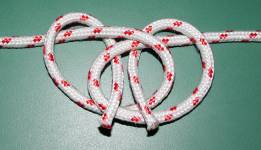 -2
-2
 -3
-3
KnotMaker drawing of pictures 1 and 2:
This bend is very easy to remember how to tie because it doesn't matter which way you pass the second end of rope through the loop in the first end of rope, and it doesn't matter if you curve the two ends of rope upwards or downwards, and it doesn't matter if you cross the two ends of rope on top of or behind the main parts of the ropes. The only thing that matters is that the two ends of rope form interlocked loops which are mirror-images of each other, and that they both pass through the center of the knot together (i.e. in the same direction).
This knot is somewhat similar to the Ashley Bend, and the Hunter's Bend, and the Shakehands Bend, and the Zeppelin Bend, and it should only be used with two ends of rope which are roughly the same thickness. All five of these bends are variations on a theme of interlocked Overhand Knots, and all five are considered to be strong and secure bends. In the pictures of these five bends, notice that the end of rope which is coming in from the left side always loops around and crosses over on top of itself. So the difference in these five bends depends on what happens with the end of rope coming in from the right side. See the Summary section for some advantages that the Alpine Butterfly Bend has over the other four similar bends.
Method #2
Wrap one end of rope once around your hand (strand #1 in picture 1 below) so that the end of the rope comes up from the bottom (as part of strand #2 in picture 1). In reality you would hold the end of rope against your palm with your thumb, unlike in the pictures. Then overlap the other end of rope with the first end of rope (as part of strand #2 in picture 1), holding both ends with your thumb, and wrap the rope around your hand so that you essentially have three strands of rope laying on the palm of your hand (picture 1 below). Grab the left-most strand (#1 in picture 1) and bring it all the way to the right over the other strands (pictures 1 and 2). Once again grab the left-most "strand" (i.e. the two overlapped ends) (#2 in picture 3) and bring the ends all the way to the right over the other two strands (pictures 3 and 4). After bringing the overlapped ends over the other two strands, push them back to the left
under
the other two strands (picture 5). The dressed knot should look like picture 3 above.
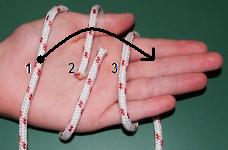 -1
-1
 -2
-2
 -3
-3
 -4
-4
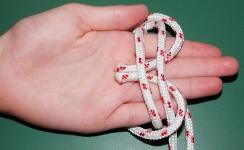 -5
-5
According to Budworth, the Alpine Butterfly can be pulled in two or three directions at once without distorting or capsizing, and he says that if your rope is damaged then you can isolate the damaged area by tying an Alpine Butterfly around it (The Complete Book of Knots, p.86-87). This indicates that the Alpine Butterfly Bend is strong and secure, because the two ends of rope can be viewed as a "damaged" section of the rope.
In The Complete Rigger's Apprentice (p.72), Brion Toss refers to this as the Strait Bend, and he says, "This knot, structurally analogous to the Butterfly Knot (Figure 3-34), is the strongest of this series and neither slips nor jams." On p.70, Toss says that in his experience, the Strait Bend (the Alpine Butterfly Bend) is on a par with the Ashley Bend, which survived 100 pulls in Ashley's testing.
Method #3
An alternate way to tie two ropes together is simply to make interlocking
Alpine Butterfly loops.

One advantage of this method is that it can be used with two ropes which have different thicknesses. Strictly speaking this is not really a bend, but if you like the Alpine Butterfly then this is an easy way to remember how to attach two ropes to each other fairly securely (the point here is that the "average" person might not recall how to tie a secure bend when needed).
Clifford Ashley invented this bend and published it in The Ashley Book of Knots, listing it simply as #1452. For this reason, people sometimes refer to it as ABOK #1452 ("Ashley Book of Knots" #1452), or as "the Ashley Bend."
To tie this knot, make a loop in the end of rope which is coming in from the left in picture 1, making sure that the end curves upward and crosses over on top of the main part of the rope. In picture 1, the end of rope coming in from the right passes over and then through the loop from the front, curving up and around to the right, then it curves downward to form a loop with the end crossing over on top of the main part of the rope. Notice that the two loops are not mirror-images of each other in picture 1. Bring both ends of rope through the center of the knot (where the two loops overlap each other) from behind (pictures 2 and 3). In picture 3, notice that the two ends of rope are passing through the center of the knot from the same direction (i.e. from behind). Dress and set the knot (picture 4), which results in a mirror-image of knot #1452 in The Ashley Book of Knots.
 -1
-1
 -2
-2
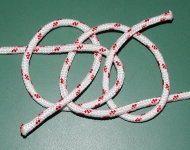 -3
-3
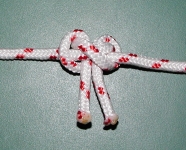 -4
-4
KnotMaker drawing of pictures 1 and 3:
This knot is somewhat similar to the Alpine Butterfly Bend, and the Hunter's Bend, and the Shakehands Bend, and the Zeppelin Bend, and it should only be used with two ends of rope which are roughly the same thickness. All five of these bends are variations on a theme of interlocked Overhand Knots, and all five are considered to be strong and secure bends. In the pictures of these five bends, notice that the end of rope which is coming in from the left side always loops around and crosses over on top of itself. So the difference in these five bends depends on what happens with the end of rope coming in from the right side. See the Summary section for some advantages that the Alpine Butterfly Bend has over the other four similar bends.
In The Complete Rigger's Apprentice (p.70), Brion Toss says that the Ashley Bend has all of the advantages of the Zeppelin Bend, but it's easier to tie. Toss also points out that the Ashley Bend survived 100 pulls in Ashley's testing (p.70).
This is simply two Bowlines tied to each other.

Ashley says that this "is about the most common of all Hawser Bends." (The Ashley Book of Knots, p.264, #1455)
For a discussion of some ways to "lock" a Bowline to make it more secure, see the forum topic called Simple lock for the bowline at the International Guild of Knot Tyers.
Method #1
First make a loop in one end of rope (which is coming down from above in picture 1), making sure that the end of the rope passes under the main part of the rope. Then bring the second end of rope completely under the loop (picture 1). Pass the second end of rope over the main part of the first end of rope, then under the first end of rope (picture 2). Now thread the second end of rope over, under, then over as in picture 3. Inspect the second end of rope very carefully to make sure that it exactly alternates between going under and going over as it threads its way through the knot. Dress and set the knot (picture 4).
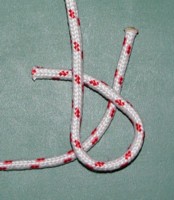 -1
-1
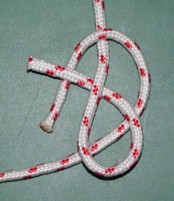 -2
-2
 -3
-3
 -4
-4
KnotMaker drawing of picture 3:
Method #2
For another way to tie the Carrick Bend, see Carrick Bend - the king of bends.
Method #3
For another way to tie the Carrick Bend, see
The Carrick Bend.
Ashley says that this is "perhaps the nearest thing we have to a perfect bend. It is symmetrical, it is easy to tie, it does not slip easily in wet material, it is among the strongest of knots, it cannot jam and is readily untied." (The Ashley Book of Knots, p.262, #1439).
According to Budworth, "Although often assumed to be strong, it is in fact only about 65% efficient. ... The symmetrical layout of the carrick bend, with eight crossing points, yields several different knots, depending on what goes over and under where. For this reason, some very unreliable knots have been misleadingly labelled carrick bends." (The Complete Book of Knots, p.43).
One big drawback of the Carrick Bend is that if you don't follow the under-over arrangement exactly right then the bend will be unsafe, and in fact various books, manuals, websites, etc., contain incorrect pictures of the Carrick Bend. However, this is a good bend for string (when tied correctly) because it's easier to untie than most of the other bends.
This bend should only be used with two ends of rope which are roughly the same thickness.
For some thoughts on the Carrick Bend, see the forum topic called Carrick Bend, revisited at the International Guild of Knot Tyers.
Method #1
This is a variation of the
Double Dragon
which turns it into a bend. In pictures 1 and 2, notice that the two ends of rope are not evenly lined up with each other. This helps them to be evenly lined up when the knot is dressed and set (picture 3).
 -1
-1
 -2
-2
 -3
-3
This bend should only be used with two ends of rope which are roughly the same thickness. However, there has been some discussion on the forum of the International Guild of Knot Tyers concerning the use of the Double Dragon as a mid-line loop or a bend because this might cause the knot to jam and be difficult to untie (for example, see the forum topic called Double Dragon vs. Double-tucked Angler).
Method #2
Here's an alternate way to make a Double Dragon Bend. Start with a
Double Sheet Bend
(picture 1). Bring the end of rope which has a red square on it down over the knot, and pass it through the "loop" at the bottom (picture 2). Dress and set the knot (picture 3). If you like this form of the Double Dragon Bend, you can also tie it by using Method #2 for tying the
Double Dragon
(start wih picture 3, and imagine that the rope has been cut where the wooden rod is).
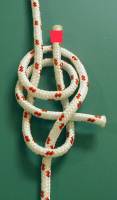 -1
-1
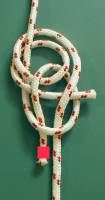 -2
-2
 -3
-3
Method #3
Another way to tie two ropes together is simply to make interlocking
Double Dragons.

One advantage of this method is that it can be used with two ropes that have different thicknesses. Strictly speaking this is not really a bend, but if you like the Double Dragon then this is an easy way to remember how to attach two ropes to each other fairly securely (the point here is that the "average" person might not recall how to tie a secure bend when needed).
See the Fisherman's Knot (below).
In this version of the Double Harness Bend, the ends of the rope come out of the knot parallel to each other. The non-parallel version is ABOK #1420.
To tie this knot, start by tying a simple Overhand Knot with both ends of rope (picture 1). In picture 1, notice that the ends of rope have created two "holes." Using the end of rope on the left, bring it down and over the main part of the other rope, then tuck it through the "hole" on the left as shown in picture 2. Now grab the other end of rope (on the right) and tuck it through the same "hole" that you tucked the other end of rope through, as shown in picture 3. Dress and set the knot (picture 4).
 -1
-1
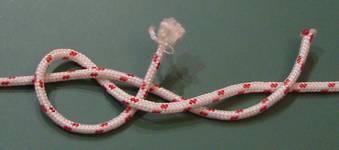 -2
-2
 -3
-3
 -4
-4
Ashley says that #1420 (the non-parallel version) "is strong and secure," and he goes on to say that #1421 (the parallel version shown above) "appears to be preferable to the former."
In addition to being strong and secure, this bend is easy to tie, and it uses very little rope or string (i.e. it's not a very bulky knot). Ashley says that it's not very easy to untie, but other people have found that it is easy to untie.
See the Sheet Bend (below).
This is essentially a "rethreaded" Figure-Eight Knot.
Method #1
Tie a
Figure-Eight Knot
in one end of a rope (picture 1), then take the other end of rope and follow all of the twists and turns of the
Figure-Eight Knot
from the other direction (pictures 2 and 3). Carefully dress and set the knot (picture 4). Make sure to dress the knot properly so that all of the strands of rope are parallel to each other and don't cross over each other unnecessarily.
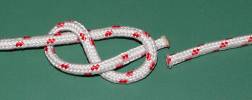 -1
-1
 -2
-2
 -3
-3
 -4
-4
KnotMaker drawing of picture 3:
This is generally considered to be a secure bend, but Ashley says that "It is bulky and bothersome to tie, and not to be preferred to [the Ring Knot], which is made in a similar manner." (The Ashley Book of Knots, p.258, #1411, brackets added).
On the other hand, Budworth says, "Writing in The Ashley Book of Knots (1944), Clifford W. Ashley deemed this knot '... bulky and bothersome to tie'. (He preferred the tape knot (p.100)). This is another instance where the needs of sailors and climbers differ" (The Complete Book of Knots, p.96).
So Ashley preferred the Ring Knot (the Tape Knot) over the Figure-Eight Bend, but Budworth feels that the Figure-Eight Bend is better for climbers. For extra security, many climbers add some type of "stopper knots" to the ends of the rope, such as Double Overhand Knots:

However, people have had serious accidents by not properly rethreading the Figure-Eight Knot (for example, see SILT HAPPENS #99-2 and do a Find on "Figure 8's vs. Bowlines").
Method #2
An alternate form of a Figure-Eight Bend is the Abnormal Figure-Eight Bend. To tie this knot, simply hold the two ends of rope together and tie a
Figure-Eight Knot:
 -1
-1
 -2
-2
The general consensus among climbers seems to be that this version is not a very reliable bend. For example, when the ropes are pulled in opposite directions then it can cause this knot to distort and become unsafe (unlike the normal Figure-Eight Bend, above).
Both forms of this bend should only be used with two ends of rope which are roughly the same thickness.
Oddly, the Fisherman's Knot is actually a bend, and the Fisherman's Bend is actually a hitch.
Using one end of rope, tie an Overhand Knot around the other end of rope (picture 1). Now flip the rope over and once again tie an Overhand Knot around the other end of rope (picture 2). In picture 1, notice that the end of rope with a blue circle on it is on the right side, and when you flip the rope over (picture 2) then the end of rope with a blue circle is now on the left side. I find that it works best if you tighten the knot in picture 1 before flipping the rope over to tie the second knot, but I left the first knot untightened in picture 2 just for the sake of clarity. After you tighten the two knots, pull them together and they should stack nicely next to each other (picture 3).
 -1
-1
 -2
-2
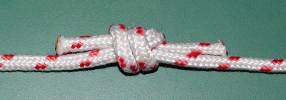 -3
-3
KnotMaker drawing of picture 2:
According to Budworth, "This is - strictly speaking - a strong and secure bend to join two similar ropes." (The Complete Book of Knots, p.39). However, climbers seem to prefer the Double Fisherman's Knot for its greater strength and security.
The Fisherman's Knot is easy to remember, and easy to tie, and it results in a small, nice-looking knot which is less bulky than most of the other bends. However, it can be difficult to untie if it has been under a strain. It should only be used with two ends of rope which are roughly the same thickness.
The Double Fisherman's Knot is even more secure than the Fisherman's Knot because it uses Double Overhand Knots instead of regular Overhand Knots.
Using one end of rope, tie a Double Overhand Knot around the other end of rope (picture 1 below). Now flip the rope over and once again tie a Double Overhand Knot around the other end of rope (picture 2 below). In picture 1 (below), notice that the end of rope with a blue circle on it is on the right side, and when you flip the rope over (picture 2 below) then the end of rope with a blue circle is now on the left side. I find that it works best if you tighten the knot in picture 1 (below) before flipping the rope over to tie the second knot, but I left the first knot untightened in picture 2 (below) just for the sake of clarity. After you tighten the two knots, pull them together and they should stack nicely next to each other (picture 3 below).
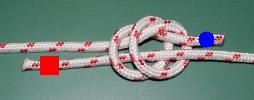 -1
-1
 -2
-2
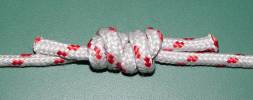 -3
-3
This bend should only be used with two ends of rope which are roughly the same thickness. It's generally considered to be a strong and secure bend, but it can be very difficult to untie.
Make a loop in the end of rope which is coming in from the left in picture 1, making sure that the end curves upward and crosses over on top of the main part of the rope. In picture 1, the end of rope coming in from the right passes over and then through the loop from the front, curving down and around to the right, then it curves upward to form a loop with the end crossing behind the main part of the rope (picture 1). Notice that the two loops are not mirror-images of each other in picture 1. Bring the end of rope on the left through the center of the knot (where the two loops overlap each other) from behind (picture 2), then bring the end of rope on the right through the center of the knot from the front (picture 3). In picture 3, notice that the two ends of rope are passing through the center of the knot from different directions (one from behind and one from the front). Dress and set the knot (picture 4).
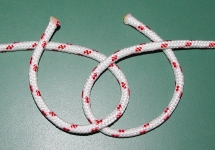 -1
-1
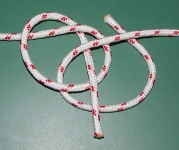 -2
-2
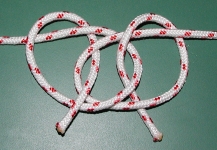 -3
-3
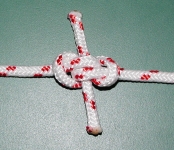 -4
-4
KnotMaker drawing of pictures 1 and 3:
This knot is somewhat similar to the Alpine Butterfly Bend, and the Ashley Bend, and the Shakehands Bend, and the Zeppelin Bend, and it should only be used with two ends of rope which are roughly the same thickness. All five of these bends are variations on a theme of interlocked Overhand Knots, and all five are considered to be strong and secure bends. In the pictures of these five bends, notice that the end of rope which is coming in from the left side always loops around and crosses over on top of itself. So the difference in these five bends depends on what happens with the end of rope coming in from the right side. See the Summary section for some advantages that the Alpine Butterfly Bend has over the other four similar bends.
This is simple and quick to tie, but it's often considered to be a weak bend. For example, when the ropes are pulled in opposite directions then this knot can distort and become unsafe.
To tie this knot, simply hold the two ends of rope together and tie an Overhand Knot.
 -1
-1
 -2
-2
KnotMaker drawing of picture 1:
Ashley says that the Overhand Bend "ranks higher than the Sheet Bend in security, but is among the weakest of the bends." (The Ashley Book of Knots, p.258, #1410).
This bend should only be used with two ends of rope which are roughly the same thickness.
This is not a bend, but I included it here because people sometimes erroneously use it as a bend. The Reef Knot is unreliable and unsafe when used as a bend.
 -1
-1
 -2
-2
For more on the Reef Knot, see the Miscellaneous Knots section.
Ashley says that the Reef Knot is admirable as a binder knot, "but under no circumstances should it be used as a bend." (The Ashley Book of Knots, p.258, #1402).
See the Vice Versa Bend (below).
This bend is often referred to as the Water Knot, but Ashley says that since there are a number of knots which are called the Water Knot, perhaps it's best to use the name Ring Knot for this bend (The Ashley Book of Knots, p.258, #1412). When it's used with strips of webbing (such as the kind that rock climbers use) then it's sometimes referred to as the Tape Knot.
To tie this knot, first tie an Overhand Knot in one end of rope (picture 1), then take the other end of rope and follow all of the twists and turns of the Overhand Knot from the other direction (pictures 2 and 3). Carefully dress and set the knot (picture 4).
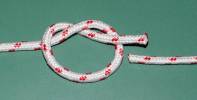 -1
-1
 -2
-2
 -3
-3
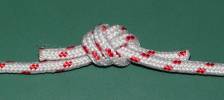 -4
-4
KnotMaker drawing of picture 3:
This is a fairly secure, nice-looking knot for tying two ropes of the same thickness, although it can be somewhat difficult to untie after being under a strain. It's also considered to be good for tying grasses, or wet rope, or rubber materials (e.g. for repairing swimming goggles), which makes it a versatile bend. Ashley says that "The Ring Knot is an excellent bend for wet gut." (The Ashley Book of Knots, p.258, #1412), and he says that it's to be preferred over the Figure-Eight Bend (The Ashley Book of Knots, p.258, #1411).
According to Budworth, "This is the bend recommended for climbers' tape or webbing. It also works in rope, cord, string and the finest monofilaments. ... Isaac Walton called this knot the water knot. Hutton referred to it as the ring knot" (The Complete Book of Knots, p.100).
First tie a Whatnot (picture 1). Grab the end of rope on the left in picture 1 and move it 90 degrees clockwise to the position shown in picture 2, then grab the end of rope on the right in picture 1 and move it 90 degrees clockwise to the position shown in picture 2. In picture 2, where the end of rope on the right (pointing upwards) crosses over itself, grab the crossing point and rotate the loop so that the end of rope is pointing downwards (picture 3). Do this by rotating the crossing point away from you so that the end of rope goes behind the main part of the other end of rope. Grab the end of rope on the left in picture 3 and bring it towards the right and push it through the loop on the right as shown in picture 4, then grab the end of rope on the right in picture 3 and bring it towards the left and push it through the loop on the left as shown in picture 4. Dress and set the knot by pulling the ends of the ropes away from each other (which will deform the knot into a "ball" shape), then pull the main parts of the ropes away from each other (picture 5).
 -1
-1
 -2
-2
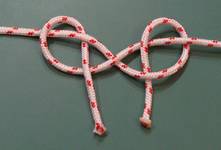 -3
-3
 -4
-4
 -5
-5
This is a flat and decorative bend in which the ends of the ropes sit nicely parallel to the main parts of the ropes. Dick Clements says that this is a secure knot which is relatively easy to untie after it has held a heavy load (see An Alternative Technique for Tying the Sennit Knot).
Make a loop in the end of rope which is coming in from the left in picture 1, making sure that the end curves upward and crosses over on top of the main part of the rope. In picture 1, the end of rope coming in from the right passes under and then through the loop from behind, curving down and around to the right, then it curves upward to form a loop with the end crossing behind the main part of the rope (picture 1). In the Ashley Bend, the end of rope coming in from the right passes over and then through the loop from the front, which is the only difference in how you tie these two knots. Notice that the two loops are not mirror-images of each other in picture 1. Bring the end of rope on the left through the center of the knot (where the two loops overlap each other) from behind (picture 2), then bring the end of rope on the right through the center of the knot from the front (picture 3). In picture 3, notice that the two ends of rope are passing through the center of the knot from different directions (one from behind and one from the front). Dress and set the knot (picture 4).
 -1
-1
 -2
-2
 -3
-3
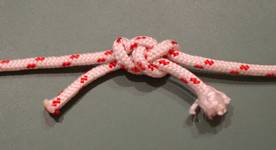 -4
-4
This knot is somewhat similar to the Alpine Butterfly Bend, and the Ashley Bend, and the Hunter's Bend, and the Zeppelin Bend, and it should only be used with two ends of rope which are roughly the same thickness. All five of these bends are variations on a theme of interlocked Overhand Knots, and all five are considered to be strong and secure bends. In the pictures of these five bends, notice that the end of rope which is coming in from the left side always loops around and crosses over on top of itself. So the difference in these five bends depends on what happens with the end of rope coming in from the right side. See the Summary section for some advantages that the Alpine Butterfly Bend has over the other four similar bends.
This is a well-known bend, but it's not generally considered to be very strong or reliable.
 -1
-1
 -2
-2
KnotMaker drawing of picture 1:
According to Budworth, "Security tests have shown it to spill after an average 22 tugs out of 100, and it is not a very strong knot, with a breaking strength of 55%." (The Complete Book of Knots, p.40).
This bend can be used with two ends of rope that are different thicknesses, as long as the thinner rope is the one which wraps around the thicker rope:
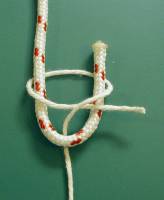
This bend is also good for tying ends of cloth together.
The Double Sheet Bend is more secure than the Sheet Bend. Simply make an extra turn with the end of rope which is coming up from the bottom, as in picture 1 below.
 -1
-1
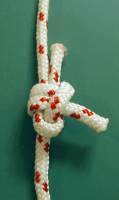 -2
-2
KnotMaker drawing of picture 1:
The Double Sheet Bend is better than the basic Sheet Bend, but it's not usually considered to be a very secure knot. In Ashley's testing, the Double Sheet Bend came apart after only 36 pulls, compared with the Ashley Bend which stayed intact through 100 pulls (see p.273 of The Ashley Book of Knots or p.70 of The Complete Rigger's Apprentice by Brion Toss).
You can make the Double Sheet Bend more secure by turning it into a Double Dragon Bend, using Method #2.
The Double Sheet Bend can be used with two ends of rope that are different thicknesses, as long as the thinner rope is the one which wraps around the thicker rope:

This bend is also good for tying ends of cloth together.
Two versions of this bend are called "Simple Simon Under" and "Simple Simon Over," and there's a doubled version and several symmetric versions as well.
To tie the "Simple Simon Under," first make a bight in one end of rope. In picture 1, the end of rope coming downwards from the top is the one which has been formed into a bight. The other end of rope will do the rest of the work, so we'll call it the Working End. Bring the Working End over the bottom of the bight and then wrap it around the bight as in picture 1, then tuck it through the bottom of the bight parallel to the way that it entered into the bight (picture 1). As the Working End wraps around the bight and then crosses itself, notice that it crosses under itself. Dress and set the knot (picture 2).
 -1
-1
 -2
-2
To tie the "Simple Simon Over," first make a bight in one end of rope. In picture 1 below, the end of rope coming downwards from the top is the one which has been formed into a bight. The other end of rope will do the rest of the work, so we'll call it the Working End. Bring the Working End over the bottom of the bight and then wrap it around the bight as in picture 1 below, then tuck it through the bottom of the bight parallel to the way that it entered into the bight (picture 1 below). As the Working End wraps around the bight and then crosses itself, notice that it crosses over itself. Dress and set the knot (picture 2 below).
 -1
-1
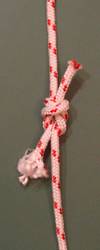 -2
-2
Notice that if you don't wrap the Working End around the bight then you would have a Reef Knot.
The Simple Simon bends are similar to the Sheet Bend (especially the Simple Simon Under), but with extra security. For even more security, see the Double Simple Simon and the Symmetric Simple Simon in Dick Clements' article called The Symmetric Simple Simon Bend.
See the Vice Versa Bend (below).
Make a loop in one end of a rope (picture 1). Pass another end of rope through the loop as in picture 2 (we'll call this the Working End). Bring the Working End up and on top of the first end of rope, then pass it down and behind the first end of rope and the main part of the first rope (picture 3). Bring the Working End up and under itself so that it forms a loop around the first rope (picture 4). Pass the Working End through the loop in the first end of rope so that the Working End is parallel to its own main part of the rope (picture 5). Dress and set the knot (picture 6).
 -1
-1
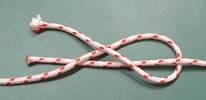 -2
-2
 -3
-3
 -4
-4
 -5
-5
 -6
-6
The Vice Versa Bend is essentially the same as the Reever Knot. The only difference is that with the Vice Versa Bend, the ends of rope both end up on the same side of the knot (compared to the main parts of the ropes), but with the Reever Knot the ends of rope end up on opposite sides of the knot (below). Compare pictures 5 and 6 above (the Vice Versa Bend) with pictures 3 and 4 below (the Reever Knot).
An easy way to tie the Reever Knot is to start with the Double Harness Bend (pictures 1 and 2 below), then pass the ends of the rope through the outer loops as in picture 3 below. Dress and set the Reever Knot as in picture 4 below.
 -1
-1
 -2
-2
 -3
-3
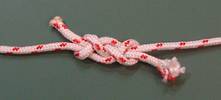 -4
-4
These knots tend to be considered as good bends for joining wet or slippery or incompatible materials such as synthetic ropes or shock elastics (e.g. bungee cords).
Dick Clements did a study of these two knots, and he seems to indicate that both versions are strong and secure, with his preference being the above Reever Knot as having the greater strength. He uses the terms "Vice Versa" and "Reever" interchangeably, which is unfortunate because when there's tension on the main parts of the rope in both of these knots, these two knots will react differently to the forces being applied.
For a discussion of these knots, see Dick Clements' article called The Vice Versa Bend and the Reever Knot, and also see the forum topic called Quiz. Name (of) this bend! at the International Guild of Knot Tyers.
For a discussion of a similar knot called the "Versa Vice Bend" (and the "Versa Vice Loop") see Dick Clements' article called The Versa Vice Bend and Its Loop Knot, and also see the forum topic called New (better?) way to tie an elegant loop knot at the International Guild of Knot Tyers.
This was Lieutenant Commander Charles Rosendahl's preferred bend for mooring the zeppelin that he commanded, which is where the name comes from.
To tie this knot, make a loop in the end of rope which is coming in from the left in picture 1, making sure that the end curves upward and crosses over on top of the main part of the rope. In picture 1, the end of rope coming in from the right forms a loop with the end curving down and crossing behind the main part of the rope. Notice that the two loops are not mirror-images of each other in picture 1, and notice that the end of rope coming in from the right does not pass through the loop on the left. Place the loop on the left on top of the loop on the right (picture 2), then bring the end of rope on the left through the center of the knot from behind (picture 3), then bring the end of rope on the right through the center of the knot from the front (picture 4). In picture 4, notice that the two ends of rope are passing through the center of the knot from different directions (one from behind and one from the front). Dress and set the knot (picture 5).
 -1
-1
 -2
-2
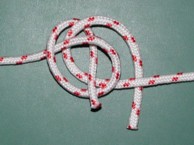 -3
-3
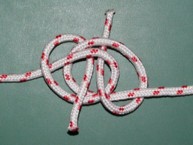 -4
-4
 -5
-5
KnotMaker drawing of pictures 2 and 4:
This knot is somewhat similar to the Alpine Butterfly Bend, and the Ashley Bend, and the Hunter's Bend, and the Shakehands Bend, and it should only be used with two ends of rope which are roughly the same thickness. All five of these bends are variations on a theme of interlocked Overhand Knots, and all five are considered to be strong and secure bends. In the pictures of these five bends, notice that the end of rope which is coming in from the left side always loops around and crosses over on top of itself. So the difference in these five bends depends on what happens with the end of rope coming in from the right side. See the Summary section for some advantages that the Alpine Butterfly Bend has over the other four similar bends.
According to Budworth, "This is probably the best of a whole trustworthy family of symmetrical bends comprising two interlocked overhand knots. It works even in big stiff hawsers and cables and is suitable for everything from hobbies to heavy industrial use. ... The knot does not have to be completely tightened before loading; it is secure even with daylight showing through it (fig. 4)." (The Complete Book of Knots, p.44).